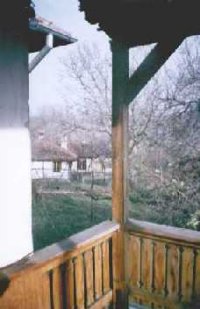|
|
| |
BULGARIA
BISTRILITZA
The village of Bistrilitza is 100 km far from Sofia, (the Capital of Bulgaria) and 17 km to the north-west of Berkovitza.In the beginning of the past century the archaeologists made some significant findings of ancient Greek , Roman and Thracian culture in the region. The village has been a center of historical Bulgarian uprisings.
The Lopushna Monastery is at 7 km from Bistrilitza. The church is famous for its stone plastics, wooden carved iconostasis and icons made by artists of the famous Samokov school (19 century).
The Klisura Monastery is near Varshetz spa. It has been ruined several times and was rebuilt in 1900 in traditional Renaissance style.
 The first town established in South Eastern Europe – Chiprovtzi is at 25 km from Bistrilitza. It is well known for the home-woven carpets in traditional style. There you can also visit Chiprovtsi Monastery.
At 65 km you can visit Belogradchik rocks and fortress. At 30 km from Belogradchik you can also visit Magura cave with its pre-historical stone paintings.
The springs of Ogosta river are at 25 km from the village of Bistrilitza. This is a very beautiful part of the region, in virgin woods, in the mountain.
At some 3.5 km from the village of Bistrilitza you will find one of the largest dams in Bulgaria, Ogosta dam. It has a swimming pool and an entertainment complex with a discotheque. The region is rich in rivers and micro-dams, suitable for fishing, water sports and rest in the open.
At 80 km from Bistrilitza is situated the historical ancient fortress “Baba Vida”.
|
|
|
Festivals and Fairs
The Great Koprivshtitza Folklore Festival
The Great Koprivshtitza Folklore Festival is Bulgaria's largest gathering of traditional musicians and singers and is a cross between a pop festival and a medieval fair. It is a sight that knows no equal: thousands of musicians and singers making the hillside above the picturesque village of Koprivshtitza their home for a few days. Coupled with this you have the colourful stalls of the traders and the thousands of visitors who come for the festival.
This is Bulgarian music as it was always played, played by the ancestors of those who first played it. But perhaps it is what happens on the periphery that is the most authentic. Strolling players or soloists, simply playing for the sheer enjoyment. forming new bonds with other musicians or just letting their music ring out over the hillside.
The Bourgas International Folk Festival
The Bourgas International Folk Festival, held annually, attracts a host of Bulgarian and international artists and is held in the second half of August.
The Kazanluk Festival
The Kazanluk Festival of the Roses is held annually in early June, and has grown from a local to an international event. Not only are the roses, Kazanluk's main industry, in full flower. but the town itself blossoms while visitors enjoy the "Rose Picnic" and all the fun of a folklore festival, with its costumes, songs and dance. Should you still have the energy left, you can always visit the old factories where the rose oil is extracted.
St. Trifon's Day
In the agricultural calendar, St. Trifon's Day celebrates the pruning of the vines, and is held on February 14.
Kukerov Den
On the first Sunday before Lent, Kukerov Den celebrates the start of the agricultural year, and all over Bulgaria you can witness processions led by the dancing. leaping Kukeri dressed in colourful masks and costumes.
Baba Marta
Baba Marta is celebrated on March 1 when peasant house-holds brush out the winter cobwebs with a traditional spring clean. and people offer each other tokens of good luck called martenitsas.
Kukeri
Like western countries. the Bulgarian calendar is dotted with important feast days and festivals. The festival of the Kukeri re-enacts ancient surovaki rites to ward off evil spirits and Kukeri fertility rites. Although only held once every five years, it brings together dancers from all over Bulgaria in a rainbow of colours and styles.
St. Lazarus Day
Lazaruvane is also celebrated in spring on St. Lazarus Day, and here village girls considered fit for marriage perform ritual songs and dances.
St. Konstantin and St. Elena Day
The coming of summer is traditionally celebrated on St. Konstantin and St. Elena Day on May 21, and in some of the remoter villages in the Stranzha hills fire dancing, dancing on heated coals, is still practised in celebration of summer's arrival. Ethnologists have suggested that this practice is directly descended from Dionysina rites of the ancient Thracian.
|